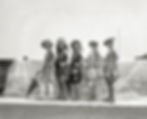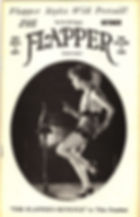
Bathing Beauties, 1922
Several period sources claim the word ‘flapper’ originated from the American fashion among teenage girls for wearing unbuckled galoshes – because their galoshes flapped about in a carefree manner as they walked. It’s a good story, literally and metaphorically, however it’s a false etymology that was widespread even in the 1920s.
The real origin of the word comes from a fledgling – a young bird flapping its wings while learning to fly. By the 1890s the term was surfacing in England as a reference to high-spirited teenage girls. The word first appeared in print in the UK in 1903 in a story about college life by Desmond Coke called ‘Sandford of Merton’.
The term was not well known in the States when a February 1907 New York Times article asked English actor George Graves to explain the meaning of the word to their American readers. His definition was “…young girls with their hair still hanging down their backs…” The following year, another article in the New York Times further explained: “A ‘flapper’… is a young lady who has not yet been promoted to long frocks and the wearing of her hair ‘up'”. In 1912 another New York Times article describes a flapper as a girl who has “just come out” (a debutante between 16 – 18 years old.)
Around the same time, the ‘flapper’ had become a standard of the theatre – a stage character who was a flirtatious, mischievous, and impetuous young woman. During World War I the use of the word increased alongside the growing number of independent young women in the home front work force. The postwar surplus of young women caused by the wartime loss of young men brought a more definitive meaning to the word ‘flapper’ and its associated styles and attitudes. In a February 5, 1920 article that appeared in the Times, Dr. R. Murray-Leslie identified the flapper as: “the social butterfly type… the frivolous, scantily-clad, jazzing flapper, irresponsible and undisciplined, to whom a dance, a new hat, or a man with a car, were of more importance than the fate of nations”.
Hollywood borrowed the term for a 1920 film ‘The Flapper’. The plot follows sixteen-year-old Genevieve as she sneaks away from her boarding school to attend a party and through a series of unfortunate events becomes the stooge of a jewel heist. The morality play blames Genevieve’s flapper behaviour when nobody believes she is innocent of the crime. Far from being a model character, flappers were often painted negatively as pleasure-seeking, hard drinking, flirtatious party girls who smoked, used slang, and had no scholastic goals.
The flapper became a staple of Hollywood films in the 1920s, often played on screen by Joan Crawford, Louise Brooks, Colleen Moore, and Clara Bow. In literature, two characters from 1925 novels best captured the flapper character: Daisy Buchanan from F. Scott Fitzgerald’s The Great Gatsby was a well-bred society flapper, and Lorelie Lee from Anita Loos’ Gentlemen Prefer Blondes was a clever gold-digging flapper. A term that also surfaced in the 1920s to describe the modern young flapper was a girl with ‘It’. The ‘It’ being sex appeal. But the flapper wasn’t wise to her sexual powers, like a vamp – she may have heavy-petted with her boyfriend but she maintained an innocent naivety.
Regardless of the negative attributes, there were flocks of young women who looked at the flapper as a role model. There was even a magazine for fans, called The Flapper. Although annual rates of subscription were offered, it seems the publication was only in print for seven monthly issues, from May to November 1922. The magazine defines the qualities of a flapper: “…coquettish, merry, independent, original and snappy…” The magazine also sings her praises in poetry:
She’s independent, full of grace,
a pleasing form, a pretty face,
is often saucy, also pert,
and doesn’t think it wrong to flirt;
knows what she wants and gets it, too;
receives the homage that’s her due;
but she is true as true can be,
her will’s unchained, her soul is free;
she charms the young, she jars the old,
within her beats a heart of gold;
she furnishes the spice of life –
and makes some boob a darn good wife!
The magazine even defined what a flapper looks like: “Bobbed hair; powder and rouge on the face; use of lip stick; ‘plucked’ eyebrows; low-cut, sleeveless bodice; absence of corset; little under-clothing, often only a teddy… high skirts; and roll-your-own stockings…”
In “Eulogy on the Flapper”, published in Metropolitan Magazine in June 1922, 22-year-old Zelda Fitzgerald wrote:
The Flapper awoke from her lethargy of sub-deb-ism, bobbed her hair, put on her choicest pair of earrings and a great deal of audacity and rouge and went into the battle. She flirted because it was fun to flirt and wore a one-piece bathing suit because she had a good figure, she covered her face with powder and paint because she didn’t need it and she refused to be bored chiefly because she wasn’t boring. She was conscious that the things she did were the things she had always wanted to do. Mothers disapproved of their sons taking the Flapper to dances, to teas, to swim and most of all to heart. She had mostly masculine friends, but youth does not need friends—it needs only crowds.
Suffragettes didn’t appreciate the flapper image – they felt flappers were silly and squandered the hard-won achievements of the suffrage movement. The term survived until the end of the decade but with the onset of the Depression in late 1929, the flapper faded. By the mid 1930s the term flapper was associated with the past decade, along with the Charleston and a bullish stock market. Nostalgia polished off any negative attributes of flapperism over the years until the term came to refer to any young, modern woman of the 1920s in a short skirt and unbuckled galoshes.

Cover of The Flapper magazine, October 1922